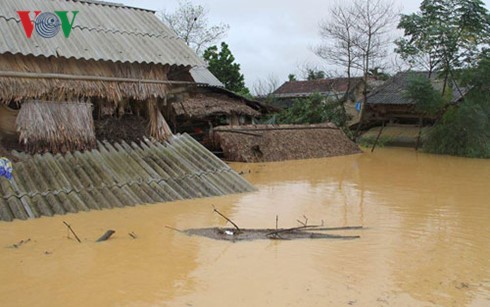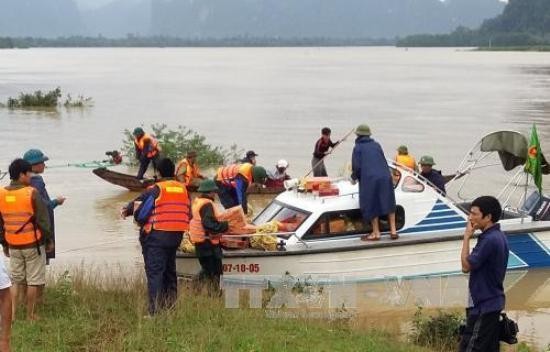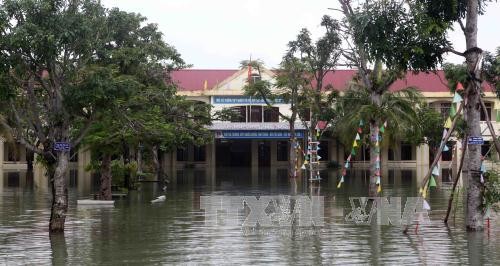(VOVworld) - Stories about typhoons, heavy rains, and flooding in Vietnam’s coastal provinces have dominated Vietnam’s media in recent days. Torrential rains inundated many parts of the central region, especially in Nghe An and Quang Binh province.
B: During the monsoon season between July and October, Vietnam is often hit by 8 to 10 tropical storms every year, which can cause heavy material and human loss. Typhoon Sarika hits northern Vietnam on Wednesday while another strong storm near the Philippines is also heading east towards Vietnam.
A: Sarika made landfall on China’s Hainan Island on Tuesday and entered the Gulf of Tonkin on Wednesday and weakened into atmospheric pressure.
 |
| Inundated houses in Vietnam's the central region |
B: As typhoon Sarika hits Vietnam, another strong typhoon, Haima, is now very close to the Philippines. It will soon make its way towards the East Sea of Vietnam.
A: We’ll keep our fingers crossed for people in the coastal regions, particularly those in areas to be directly hit by the typhoon. Now let’s continue reading letters from our listeners. John Fisher from Massachusetts in the US sent a reception report for VOV’s program on September 30 on the frequency of 7315khz. He used a Drake R-8 Communications Receiver which has a DYMEK all band whip antenna.

Quang Binh authority brings food and essential goods to people isolated areas by floods. |
B: John’s reception report was correct with our station log and we’ll surely send you a verification card. We’re so glad to read your compliment. “I find your broadcasts about Vietnam very informative. I learn much about your country and its history. I also enjoy the nice music. I hope you will continue to broadcast on shortwave radio. Vietnam must continue to have a radio voice. Please accept my very best wishes.”
A: Thank you very much John for listening to VOV and supporting shortwave. While developing online radio, VOV has continued to invest in radio broadcasting inside and outside Vietnam as radio remains one of our most effective communication channels. From Japan Toshiya Nishimura reported listening to our program on September 7 from 11h30 to 11h57 UTC on the frequency of 12020khz. As usual, Toshiya’s reception report noted detailed information on our program. You’ll get our verification card soon.
 |
| Nghen school in Can Loc district, Quang Binh province, was inundated |
B: Toshiya noted more noise during the program and rated SINPO at 44333 or 34222. He asked about the weather in Vietnam. Does it change a lot, affecting shortwave broadcasting?
A: Yeah maybe the change of weather has affected the signal, especially when you are receiving a shortwave station from a long distance away. It’s the end of the autumn and close to winter in Vietnam. The temperature has reduced to around 30DC, which is about 7 to 10 DC lower than in the summer.
B: I suggest you try moving your antenna to a different location or orientation to avoid obstruction from a high-rise building or signal deflection by some other surface near your house.
A: We hope to receive more feedback from you soon to tell us about the quality of our broadcast where you live. As you said, the Internet radio has a good, stable signal. In fact, most of our loyal listeners share your feeling that shortwave is an attractive medium and they are committed to continuing to listen to shortwave.
B: Paul Walker in Alaska, the US, listened to our program on October 15th on the frequency of 7315khz and gave a SINPO rating of 55434. He said the signal was excellent but choppy propagation made it a bit hard to listen to. Paul I used a Tecsun PL880, a Wellbrook ALA1530LNP magnetic loop, an EmTech ZM2 antenna tuner, and a DX Engineering HF PreAmp.
A: Like many other listeners, Paul always enjoys Vietnamese music. The signal was good enough to sit down and listen, allowing him to enjoy the music and understand everything, Paul said.
B: From Indonesia, Fachri Fachri submitted a reception report for VOV’s English language broadcasts directed to Asia on October 13 on the frequency of 12020kHz and 9840kHz. He rated the signal quality on 12020khz a little bit better than on 9840 khz.
A: Thank you very much for listening to VOV on multiple frequencies and sending us your remarks, which helps us monitor our overseas broadcast. Your reports are sufficient for us to verify them, so we’ll send you a QSL card along with the VOV program guide and frequency schedule you requested.
B: We received an email from Rich DeLuca from Indiana, the US, telling us that he listened to us on Tuesday on the frequency of 7315 khz. He said “A great music show coming in loud and clear. I loved the music show and a song called Dragon Fly. My radio is an SW7600GR Sony with a 100 foot long wire antenna. Keep up the good work.”
A: This week many listeners in the US reported a good signal on the frequency of 7315khz. That’s good news for us. We hope to continue receiving your feedback to help us improve our overseas broadcast.
B: This week we acknowledge letters and reception reports from Pak Ning Tjang of Indonesia, P.S Sekar of India, Richard Lemke of Canada, Mizan Rahman of Bangladesh, and Rolf Johansson and Christian Altenius of Sweden.
A: Thank you, listeners, for tuning in to our program and sending us feedback. We’ll verify your reception reports and hope you’ll receive our QSL cards soon. We welcome your feedback at: English Section, VOVworld, Voice of Vietnam, 45 Ba Trieu Street, Hanoi, Vietnam.
B: Our email address is englishsection@vov.org.vn. Thank you for listening to VOV on shortwave and online and for visiting our website at vovworld.vn. Good bye until next time.